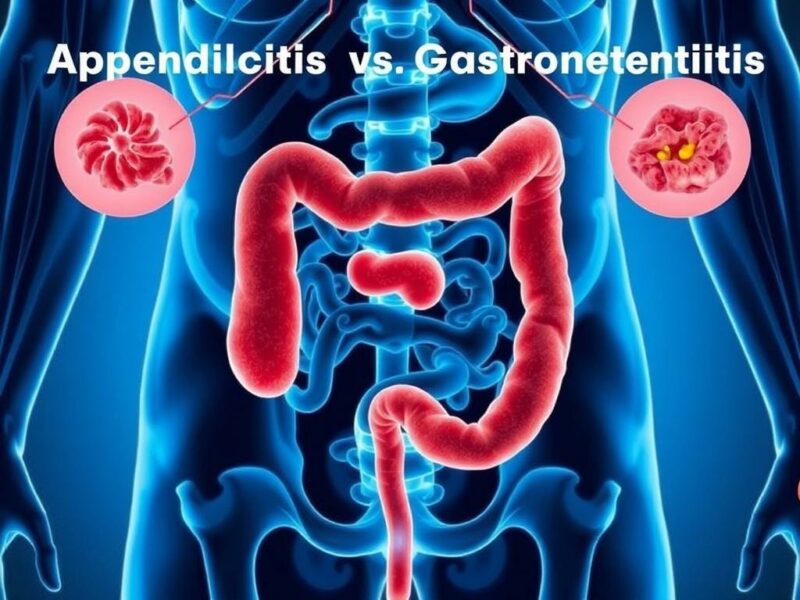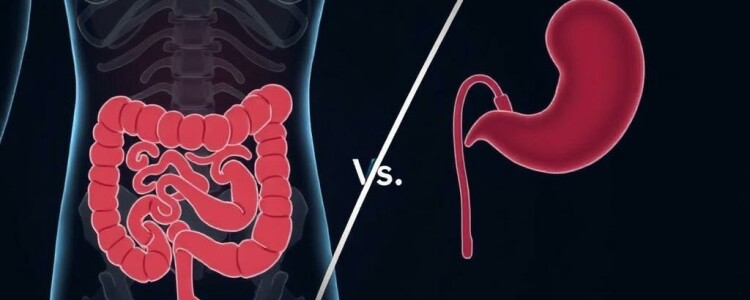When it comes to abdominal pain, two conditions often come into question: appendicitis and gastroenteritis. Both can cause discomfort and digestive issues, but knowing the differences between these two ailments is crucial. Misunderstanding the symptoms might lead to delayed treatment, which, in some cases, can result in serious complications. So, what exactly separates appendicitis from gastroenteritis? How can one identify the symptoms, and when should medical help be sought? Let’s dive into the topic and break down everything you need to know about these two common but often confused conditions.
What Is Appendicitis?

Appendicitis is the inflammation of the appendix, a small finger-shaped pouch attached to the large intestine. Although the appendix doesn’t have a significant known function in the human body, when it becomes inflamed or infected, it requires urgent medical attention. Appendicitis usually starts with mild pain near the belly button, which gradually intensifies and shifts to the lower right abdomen. The inflammation can lead to the appendix bursting if left untreated, causing severe, potentially life-threatening complications.
This condition often affects children, teenagers, and young adults, though anyone can develop appendicitis. It is commonly caused by a blockage inside the appendix, such as hardened stool, a foreign body, or infection that prompts swelling and irritation. Identifying appendicitis quickly is essential because the only effective treatment is surgical removal of the appendix, typically performed as an appendectomy.
Key Symptoms of Appendicitis
The symptoms of appendicitis can sometimes be misleading, as they may overlap with other illnesses. However, some common warning signs include:
- Sharp pain starting around the navel and moving to the lower right abdomen
- Increasing pain intensity over several hours
- Nausea and vomiting
- Loss of appetite
- Fever, usually low-grade but sometimes higher in advanced cases
- Abdominal swelling or bloating
- Inability to pass gas
The intensity and location of pain are crucial clues. The classic symptom is a shift in pain location, which helps differentiate appendicitis from other issues.
What Is Gastroenteritis?
Gastroenteritis, often referred to as the stomach flu, is an inflammation of the stomach and intestines typically caused by viruses, bacteria, or parasites. Unlike appendicitis, gastroenteritis affects a larger portion of the digestive system and is usually less severe. The primary symptoms of gastroenteritis include diarrhea, vomiting, stomach cramps, and sometimes fever.
This condition is highly contagious and often spread through contaminated food, water, or contact with an infected person. Most cases of gastroenteritis are self-limiting, meaning they resolve on their own with proper hydration and rest, but severe cases or infections caused by certain bacteria might require medical treatment.
Common Symptoms of Gastroenteritis
The symptoms of gastroenteritis can overlap with appendicitis, especially because both involve abdominal discomfort and vomiting. However, gastroenteritis generally presents as:
- Sudden onset of nausea and vomiting
- Watery diarrhea
- Stomach cramps and bloating
- Low fever or chills
- Muscle aches and fatigue
- Loss of appetite
Gastroenteritis symptoms usually appear quickly after exposure to the infectious agent and last for a few days, depending on the cause and severity.
Causes: What Triggers Appendicitis and Gastroenteritis?
Understanding the root cause of both appendicitis and gastroenteritis helps clarify how differently these conditions arise, even though they cause digestive distress.
| Condition | Main Causes |
|---|---|
| Appendicitis |
|
| Gastroenteritis |
|
Notice how appendicitis involves a mechanical or localized blockage leading to inflammation, while gastroenteritis results from an infection affecting the entire gastrointestinal tract.
How Are Appendicitis and Gastroenteritis Diagnosed?
Because symptoms can overlap, it’s important to rely on thorough examinations and diagnostic tests to distinguish appendicitis from gastroenteritis. Both conditions might show abdominal pain and nausea, but the nature of symptoms differs.
Diagnosing Appendicitis
Physicians usually start by performing a physical exam to assess pain location, tenderness, and signs of abdominal guarding or rebound tenderness (pain upon releasing pressure). Key diagnostic techniques include:
- Blood tests: looking for elevated white blood cells signaling infection
- Urinalysis: to rule out urinary tract infection or kidney stones
- Imaging: ultrasound and especially a CT scan of the abdomen are highly effective in detecting inflamed appendix
Early diagnosis is vital. In some cases, surgeons might opt for diagnostic laparoscopy if imaging is unclear.
Diagnosing Gastroenteritis
Gastroenteritis diagnosis is often based on clinical symptoms and patient history. Since symptoms are usually acute and related to recent food or water exposure, tests are less commonly needed but can include:
- Stool cultures or antigen tests to identify bacterial or viral pathogens
- Blood tests if severe dehydration or systemic infection is suspected
Most people recovering from gastroenteritis don’t require imaging or invasive diagnostics unless complications arise.
Treatment Options for Appendicitis and Gastroenteritis
Once diagnosed, treatment plans for appendicitis and gastroenteritis differ significantly due to their distinct causes.
Treatment for Appendicitis
Appendicitis is considered a medical emergency. The standard treatment involves surgical removal of the appendix before it ruptures. There are two main approaches:
- Laparoscopic appendectomy: minimally invasive surgery using small incisions
- Open appendectomy: traditional surgery with a larger incision
Before surgery, antibiotics are usually administered to prevent infection spreading. If the appendix has already burst, a longer hospital stay and extended antibiotic therapy might be required.
In some cases, where surgery is risky or delayed, conservative management with antibiotics alone is attempted, but surgery remains the preferred treatment.
Treatment for Gastroenteritis
Since gastroenteritis is mostly viral, treatment focuses on symptom relief and preventing dehydration. Key management strategies include:
- Rehydration: oral rehydration solutions or intravenous fluids for severe cases
- Rest: allowing the body time to recover
- Diet: gradually reintroducing easy-to-digest foods (bananas, rice, toast)
- Medications: anti-diarrheal drugs or antibiotics, used only if bacterial infection is confirmed
It’s important to avoid anti-diarrheal medications in children or cases of severe infection without medical advice, as they can worsen the condition.
Comparing Symptoms: Appendicitis vs. Gastroenteritis
To help readers quickly understand the symptom differences, here’s a comparative overview:
| Symptom | Appendicitis | Gastroenteritis |
|---|---|---|
| Onset of pain | Gradual, starts near navel and shifts | Sudden, generalized abdominal discomfort |
| Pain location | Lower right abdomen | Diffuse abdominal cramping |
| Vomiting | Common, follows pain | Common, can be severe |
| Diarrhea | Uncommon | Very common |
| Fever | Low-grade to moderate | Low-grade or absent |
| Loss of appetite | Common | Common |
| Duration | Persistent, worsens without treatment | Usually resolves within days |
When to Seek Medical Help?

Knowing when to see a doctor can prevent unnecessary suffering and complications. For appendicitis, immediate medical attention is crucial if you experience:
- Severe abdominal pain, especially shifting to the lower right area
- Persistent vomiting
- Fever with abdominal tenderness
- Inability to eat or drink
- Swelling or a hard belly
For gastroenteritis, seek medical help if you experience:
- Signs of dehydration (dry mouth, dizziness, decreased urination)
- High fever
- Blood in vomit or stool
- Symptoms lasting more than 3 days
- Severe abdominal pain
Remember, when in doubt, consult a healthcare professional to ensure proper diagnosis and treatment.
Preventing Appendicitis and Gastroenteritis
While appendicitis isn’t entirely preventable due to its often sudden onset, maintaining a healthy gut and diet might reduce risks associated with digestive blockages. A diet rich in fiber, fluids, and regular bowel habits can help prevent constipation, a factor implicated in appendicitis.
Preventing gastroenteritis revolves around hygiene and food safety:
- Wash hands regularly, especially before meals and after using the bathroom
- Ensure food is cooked thoroughly
- Drink clean, treated water
- Avoid close contact with infected individuals
- Clean and disinfect contaminated surfaces
These measures significantly reduce the chance of infection with viruses or bacteria that cause gastroenteritis.
Summary Table: Appendicitis vs. Gastroenteritis
| Aspect | Appendicitis | Gastroenteritis |
|---|---|---|
| Cause | Appendix inflammation due to blockage | Infection of stomach/intestines (viral, bacterial, parasitic) |
| Primary Symptom | Localized abdominal pain | Diarrhea and vomiting |
| Treatment | Surgery (appendectomy) and antibiotics | Supportive care, fluids, antibiotics if bacterial |
| Onset | Gradual worsening | Sudden onset |
| Contagion | Not contagious | Highly contagious |
Conclusion
Navigating the symptoms of appendicitis versus gastroenteritis can feel confusing, but understanding the key differences can make a significant impact on timely medical decisions. Appendicitis is a surgical emergency characterized by localized pain that worsens over time, whereas gastroenteritis typically involves widespread stomach discomfort with vomiting and diarrhea and resolves without surgery. Both require attention but differ markedly in severity, treatment, and urgency. When abdominal pain strikes, paying close attention to symptoms, their progression, and associated signs helps guide whether quick medical intervention is necessary. Ultimately, a prompt diagnosis and appropriate treatment can mean the difference between a swift recovery and serious complications. If you or a loved one experiences symptoms that seem severe or unusual, do not hesitate to seek medical advice—your health and peace of mind depend on it.



